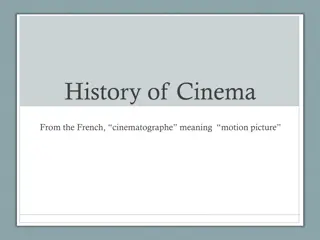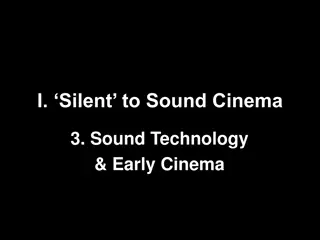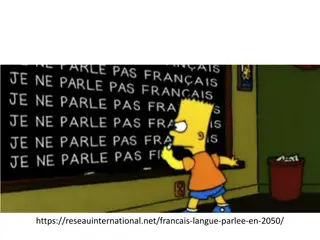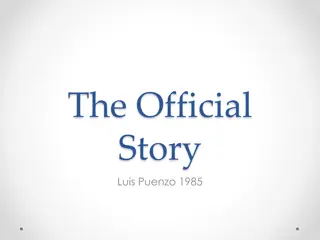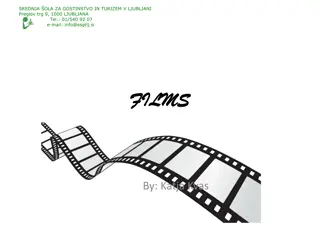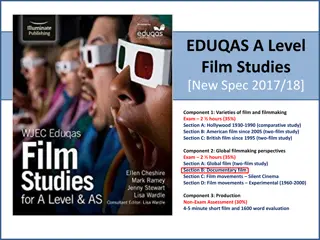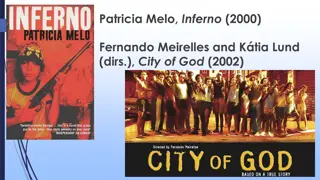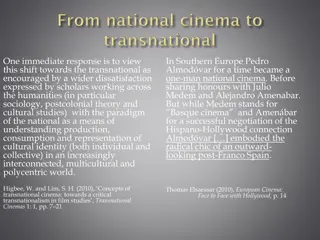Insights into Early European Film Movements and French Cinema Pioneers
Jean Renoir, a prominent figure in early French cinema, created films that challenged societal norms and class structures. His works, such as "Grand Illusion" and "Rules of the Game," depicted social and political sensitivities of the time. Andre Bazin, a French theorist, admired Renoir's films and explored the essence of cinema in his writings. Contrasting Soviet Montage with realism, the aesthetic of realism emphasizes composition and contemplation, while Montage seeks meaning through editing, directing viewers' attention.
Download Presentation

Please find below an Image/Link to download the presentation.
The content on the website is provided AS IS for your information and personal use only. It may not be sold, licensed, or shared on other websites without obtaining consent from the author.If you encounter any issues during the download, it is possible that the publisher has removed the file from their server.
You are allowed to download the files provided on this website for personal or commercial use, subject to the condition that they are used lawfully. All files are the property of their respective owners.
The content on the website is provided AS IS for your information and personal use only. It may not be sold, licensed, or shared on other websites without obtaining consent from the author.
E N D
Presentation Transcript
Early European Film Movements Jean Renoir: Early French Cinema
Jean Renoir: b. September 15, 1894, Montmartre, Paris, Franced. February 12, 1979, Beverly Hills California, U.S.A. Today his films are considered to be in the canon of the greatest films ever made At the time they were made, they weren t considered to be fully realized The generation of French filmmakers in the 60 s and 70 s identified with his films Son of the the painter Pierre-Auguste Renoir Renoir's films show strong social and political sensitivity to the inequality of the French class structure and sympathy for the working class. The bleak pessimism and anarchic escapes from bourgeois conventions depicted in his films, are partly a response to the depression of the early 30s
30s Renoir made many popular films in the early 30 s Joined the popular front (a group of leftists who were in apposition to Nazi sympathizers) Made Grand Illusion 1937 and Rules of the Game 1939 The former was the only one that was well received at the time
Bazin: What is Cinema Bazin was one of the French theorists of the 60 s and 70 s who developed an appreciation for Renoir s work
Bazin asked What is Cinema? in his famous article How does Cinema relate to our being? How do certain approaches to life and the social being find cinematic expression? How does cinema help us approach the mystery of the human: the real that element of our existence toward which we incline
Realism Opposite end of the spectrum as montage Soviet Montage sought to construct meaning through editing The realist aesthetic is about composition and contemplation The use of deep space (deep focus and long shots) are part of the aesthetic of realism Soviet Montage directs or restricts the viewer s attention and limits the viewer s capacity for contemplation Destroys the ambiguity inherent in reality Presents a judgment (by the director) on reality itself
Side by Side Comparison Realist Aesthetic Montage Aesthetic
Cahier du Cinema Influential French film magazine founded in 1951 by Andr Bazin Not only valued the European makers of realist works, but also, Orson Welles and John Ford Appreciated the use of mise en scene and deep space to communicate ideas
Elements of Mise en Scene Set/Location Staging Movement Lighting Costume Make-up Performance
Rules of the Game 1939 Seems like a country farce Subtext: Europe was going to war. In France, left-wing Popular Front members like Renoir were clashing with Nazi sympathizers. Renoir's portrait of the French ruling class shows them as silly adulterous twits, with the working classes emulating them within their more limited means. Ebert Renoir recalls that a man set fire to his newspaper at the movie's premiere, trying to burn the theater down. Audiences streamed out, the reviews were savage, and the film was a disaster, even before it was banned by the occupying Nazis. The French like to be funny, but they do not much like to be made fun of. "We were dancing on a volcano," Renoir said.
Non-traditional Plot The camera drifts from person to person communicating an experience rather than a plot. Ruminations on themes (violence and dishonesty) Also a melancholy pre-war look at joy: That on the brink of
Deep Space No less visually impressive than Citizen Kane (which was known for deep focus) Every person within the frame is acting at all times (in the foreground and the background) Subplots unfold in the background using deep space to communicate multiple moments at once There is a freedom there for the viewer, because she can observe the part of the frame that she wants. The director relinquishes some control over where the audience s attention will land That sort of ambiguity, according to Bazin, can only be achieved through long takes and deep focus











